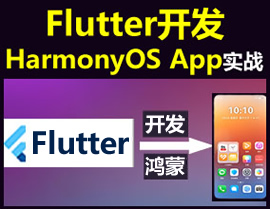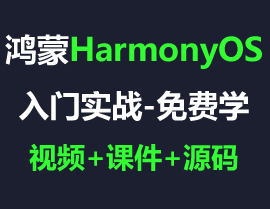HarmonyOS 鸿蒙Next北向应用:自定义dialog布局实践
HarmonyOS 鸿蒙Next北向应用:自定义dialog布局实践 研学之自定义 dialog 布局实践。
显示效果:
点击图中的文字进行下一步
代码的实现:
第一个布局文件
<?xml version="1.0" encoding="utf-8"?>
<DirectionalLayout
xmlns:ohos="http://schemas.huawei.com/res/ohos"
ohos:height="match_parent"
ohos:width="match_parent"
ohos:orientation="vertical">
<Button
ohos:id="$+id:text_01"
ohos:width="match_content"
ohos:height="match_content"
ohos:text_size="30fp"
ohos:text="Dialog显示"
ohos:top_margin="0vp"
ohos:text_color="red"/>
</DirectionalLayout>第二个布局文件
<?xml version="1.0" encoding="utf-8"?>
<DirectionalLayout
xmlns:ohos="http://schemas.huawei.com/res/ohos"
ohos:width="match_parent"
ohos:height="match_content"
ohos:padding="10vp"
ohos:background_element="grey"
ohos:orientation="vertical">
<Text
ohos:width="match_parent"
ohos:height="match_content"
ohos:text="Dialog标题"
ohos:text_color="Black"
ohos:text_style="bold"
ohos:text_size="40fp"/>
<Text
ohos:width="match_parent"
ohos:height="match_parent"
ohos:text="自定义Dialog内容"
ohos:text_color="Black"
ohos:text_style="bold"
ohos:weight="1"
ohos:text_alignment="vertical_center"
ohos:top_margin="30vp"
ohos:bottom_margin="30vp"
ohos:left_margin="10vp"
ohos:right_margin="10vp"
ohos:text_size="30fp"/>
<DirectionalLayout
ohos:height="match_content"
ohos:width="match_parent"
ohos:orientation="horizontal">
<Button
ohos:width="match_parent"
ohos:text="取消"
ohos:text_size="30fp"
ohos:padding="10vp"
ohos:text_color="White"
ohos:weight="1"
ohos:margin="10vp"
ohos:background_element="yellow"
ohos:height="match_content"/>
<Button
ohos:width="match_parent"
ohos:text="确定"
ohos:text_size="30fp"
ohos:weight="1"
ohos:padding="10vp"
ohos:text_color="White"
ohos:margin="10vp"
ohos:background_element="green"
ohos:height="match_content"/>
</DirectionalLayout>
</DirectionalLayout>然后进行绑定
package com.example.jltfdialog.slice;
import com.example.jltfdialog.ResourceTable;
import ohos.aafwk.ability.AbilitySlice;
import ohos.aafwk.content.Intent;
import ohos.agp.components.Button;
import ohos.agp.components.Component;
import ohos.agp.components.LayoutScatter;
import ohos.agp.window.dialog.CommonDialog;
public class MainAbilitySlice extends AbilitySlice {
@Override
public void onStart(Intent intent) {
super.onStart(intent);
CommonDialog commonDialog = new CommonDialog(this);
super.setUIContent(ResourceTable.Layout_layout1);
Button button= (Button) findComponentById(ResourceTable.Id_text_01);
button.setClickedListener(new Component.ClickedListener() {
@Override
public void onClick(Component component) {
Component component1 = LayoutScatter.getInstance(getContext())
.parse(ResourceTable.Layout_ability_main, null, true);
commonDialog.setSize(800, 500);
commonDialog.setContentCustomComponent(component1);
commonDialog.show();
}
});
}
@Override
public void onActive() {
super.onActive();
}
@Override
public void onForeground(Intent intent) {
super.onForeground(intent);
}
}要看看具体的内容类型,属于通用开发的内容啦。
更多关于HarmonyOS 鸿蒙Next北向应用:自定义dialog布局实践的实战系列教程也可以访问 https://www.itying.com/category-93-b0.html
fraction里面那个context如何获取?
在HarmonyOS鸿蒙Next中,自定义Dialog布局可以通过ArkUI框架实现。首先,创建一个自定义Dialog组件,使用@Component装饰器定义组件结构。在组件内部,使用@Builder装饰器定义布局内容,包括文本、按钮等UI元素。通过@State装饰器管理组件的状态,如显示或隐藏Dialog。在父组件中,使用@Link装饰器绑定Dialog的显示状态,并通过事件触发Dialog的显示或隐藏。具体实现如下:
@Component
struct CustomDialog {
@State isShow: boolean = false;
@Builder
buildContent() {
Column() {
Text('自定义Dialog内容')
.fontSize(20)
.margin({ bottom: 20 });
Button('关闭')
.onClick(() => {
this.isShow = false;
});
}
.padding(20)
.backgroundColor(Color.White)
.borderRadius(10)
}
build() {
if (this.isShow) {
Dialog.show({
builder: this.buildContent
});
}
}
}
@Entry
@Component
struct ParentComponent {
@Link isShow: boolean;
build() {
Column() {
Button('显示Dialog')
.onClick(() => {
this.isShow = true;
});
}
.padding(20)
}
}在HarmonyOS鸿蒙Next中,自定义Dialog布局可以通过以下步骤实现:
-
创建布局文件:在
resources/base/layout目录下创建XML布局文件,定义Dialog的UI结构。 -
继承Dialog类:在Java或Kotlin中创建一个类继承
ohos.agp.window.dialog.CommonDialog,并在构造函数中加载自定义布局。 -
设置布局:在
onCreate()方法中使用setContentLayout()方法设置自定义布局。 -
处理交互:在自定义Dialog类中处理按钮点击等交互逻辑。
-
显示Dialog:在需要的地方实例化自定义Dialog并调用
show()方法显示。
通过以上步骤,可以灵活定制Dialog的外观和行为,满足不同应用场景的需求。








